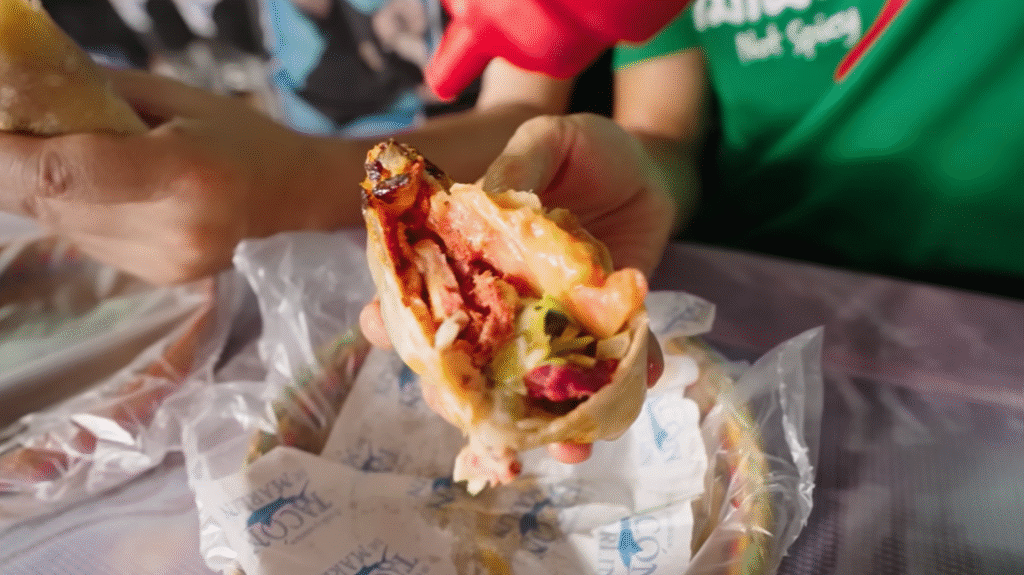With stings of sweet-sour brightness, tamarind is having a year, and the momentum feels like a swarm of bees moving with a common goal, foraging across bar programs and tasting menus. Chefs whisk it into chile jams that go especially well with fried seafood and charred vegetables, and bartenders fold it into pineapple coolers.
Mushroom cooking has advanced beyond novelty in recent years, demonstrating how a highly adaptable ingredient can be manipulated, pressed, and smoked to create meaty textures without impersonation. When seared in ghee, king oyster “scallops” have a familiar yet remarkably similar flavor to shellfish, and when patiently braised, lion’s mane birria provides fibers that shred like brisket and satiate remarkably effective comfort cravings.
Several kitchens reported that by using advanced analytics on ordering and waste, they were able to significantly reduce spoilage and improve consistency by focusing on a few heritage-grain dishes and trimming lengthy menus. The nuttiness of the millets reads as exceptionally durable on the plate, holding shape in pilafs and soaking up salsas without becoming muddy. Chefs also talk about the almost perfumey depth of masa made from landrace corn.
| Attribute | Details |
|---|---|
| Full Name | Tejal Rao |
| Professional Title | Critic at Large, Food section |
| Current Employer | The New York Times |
| Primary Location | Los Angeles, USA |
| Beat & Focus | Cross-cultural dining, diaspora cuisines, chef-driven innovation, emerging restaurant movements |
| 2025 Reporting Themes | Mexican–Indian culinary crossovers; plant-forward cooking with mushrooms and mycelium; “swicy” desserts; tamarind’s rise; non-alcoholic pairings; live-fire techniques (tandoor and trompo) |
| Signature Piece (Reference) | “This Is the Moment for Mexican Indian Food to Flourish” (May 2, 2025) — https://www.nytimes.com/2025/05/02/dining/mexican-indian-food-usa.html |
| Notable Subjects Covered | Mirra (Chicago); Saucy Chick (Los Angeles area); Masala y Maíz (Mexico City); regional Mexican dishes (tacos rojos potosinos, pescadillas); Indian regional currents (Malvani seafood, Assamese flavors) |
| Known For | Elevating overlooked culinary histories; connecting technique to culture; reporting that blends rigorous sourcing with vivid, accessible storytelling |
| Editorial Style | Conversational yet precise; optimistically framed; analytically rigorous; attentive to supply chains, regionality, and sustainability |
| Areas of Expertise | Indian and Mexican regional cuisines; condiments (salsas/chutneys); grain traditions (maíz/nixtamal, millets); beverage trends (aguas frescas, chaas, zero-proof cocktails) |
| Professional Highlights | Widely cited critic and columnist; frequent features that spark national conversation on culinary identity and heritage |
| Recognition | Recipient of major food-writing honors and industry accolades for criticism and cultural reporting |
| Industry Impact | Spotlighting heritage grains and transparent sourcing; bringing diaspora narratives into mainstream dining coverage; influencing menus through trend analysis |
| Key 2025 Trend Insights | Tamarind as headline flavor; mycelium and mushroom texture techniques; seacuterie boards; internationally inflected sandwiches; floral accents; transparent labeling and provenance |
| Approach to Sources | Chefs, farmers, millers, spice importers, and historians; triangulates interviews with on-site tastings and archival research |
| Typical Story Formats | Critic’s notebook; reported feature; chef/restaurant profile; movement trendline with regional case studies |
| Audience | Culinary professionals, curious diners, policy watchers tracking food systems, and readers seeking culturally grounded dining maps |
| Education & Training | Journalism and literature studies as publicly profiled; ongoing fieldwork across restaurants, markets, and producer networks |
| Speaking & Panels | Regular conversations on food, identity, and sustainability with chefs, academics, and industry leaders |
| Contact Path | Through The New York Times channels and author page (no direct email publicly listed) |
| Ethical Compass | Attribution-first, culturally sensitive framing, and care around community histories and ownership of food narratives |

Rotis and tortillas are made into more than just carriers thanks to strategic alliances with small millers and nixtamal experts. With its ghee gloss, Amul pull, and green chile bite, this roti-quesadilla hybrid pays homage to Punjabi-Mexican homes while simultaneously delivering both nostalgia and novelty.
From a stunt to a standard, spicy baking has evolved. Mango-habanero crullers, honey-chipotle banana loaves, and maple-jalapeño palmiers may sound like fun, but their purpose is very clear: they balance fat, fruit, and heat to keep you craving more. Once cautious, pastry chefs now find the format to be very dependable for attracting repeat business, particularly when the spice is visible rather than concealed.
In culinary education, young chefs are taught to value provenance just as much as plating and to read labels like archivists. Trust has increased and guest complaints regarding mystery ingredients have significantly decreased since the introduction of stricter sourcing notes on menus. Some bakeries have secured data transactions that diners never see but silently appreciate by incorporating blockchain technology for traceable cacao and vanilla.
Once a specialty, seacuterie boards have become popular with a surprisingly low cost. On a plate, smoked trout rillettes could be served with citrusy ceviche, a ribbon of kelp salad, and canned sardines in olive oil. Because brininess enjoys everything from a crisp albariño to a jasmine-ginger spritz, the format is especially creative for gatherings that include both drinkers and zero-proof devotees.
Live-fire has developed into a multilingual educator. The rotation, closeness, and fat management strategies used by trompos and tandoori make food taste much quicker to the palate—flavor is felt instantly. Al pastor pork enlivened with fennel pollen and Malai-brushed chicken kissed by mesquite sit next to each other; both arrive shimmering, their edges lacquered and deeply seasoned, simplifying operations and allowing cooks to plate calmly.
Rotisserie chicken and masa kits moved from pop-ups to permanent counters during the pandemic, setting the stage for the handheld renaissance in 2025. These days, kati-roll quesabirria, Acapulco pescadillas, and tacos rojos potosinos are popular alongside chaat-layered tostadas. These dishes share a common street-born pragmatism and crowd-pleasing crunch.
Zero-proof has soared from afterthought to anchor in the last ten years. Thoughtful acid and texture significantly enhance toasted-corn horchatas, rose-salt lassis, and tamarind-black lime coolers. According to beverage directors, the category is highly adaptable in combining spicy desserts with live-fired proteins, persuading skeptics with drinks that are, quite simply, mouthwatering.
The difficulty for medium-sized enterprises is frequently embracing heritage grains without becoming overly involved in procurement. To solve this, operators freeze dough in tightly portioned pucks after batch-nixtamalizing once or twice a week. Cooks can concentrate on fillings and garnishes that vary depending on the market thanks to this highly effective technique that maintains quality during rushes.
Chefs are working with local importers of spices and tortillerías to align menus with values rather than just trends. In one city, a lamb barbacoa biryani arrives under pastry, its steam scented with curry leaves and roasted chiles; in another, a Gujarati chaas riff meets Sinaloan aguachile. Cooks who grew up crossing pantry lines without ceremony highlight these mash-ups, which are living archives rather than gimmicks.
Durable crops like heritage maize and millets are more than just nostalgic in the face of climate stress. In addition to having a flavor that is frequently deeper, more mineral, and, when handled carefully, more nuanced than commodity grains, they are incredibly resilient against unpredictable seasons. Restaurants gain distinction; diners taste place rather than abstraction; farmers report higher margins.
Guest inquiries have greatly decreased friction at service, and back-of-house training has improved since a few progressive kitchens implemented house labeling for sodium, sugar, and additive phosphorus. Although they are straightforward indicators, the clear icons next to the dishes—pasture-raised, stone-ground, and nixtamalized—feel especially helpful for families keeping track of values and allergies.
Teams led by immigrants are recovering credit lines that were previously mistakenly attributed to anonymous “fusion” through strategic alliances. Some owners credit Chicago’s Mirra for their technique-driven compositions, while others commend Saucy Chick for its casual approach, weeknight-friendly cuisine, and community-building. Masala y Maíz is credited with coining the term “mestizaje” as a frame.
Funding is still the largest obstacle for early-stage startups, but ideas that combine transparent sourcing with well-known formats are gaining traction. When the story is well-written and the training is comprehensive, investors discreetly observe that menus that emphasize legumes, heirloom corn, and mushrooms can be surprisingly inexpensive to operate while still feeling high-end.
Kitchens are simplifying operations and changing workflows by utilizing advanced prep lists and cross-utilizing ingredients, such as raita that anchors a cucumber margarita foam or achar that doubles as a wing glaze. Richer, cleaner-reading food that flows from pass to table at a pace that keeps patrons interested and servers at ease is the end result.
A straightforward yet powerful concept has gained popularity recently thanks to social media: eating with your hands is mindful and not messy. When cutlery is optional and conversation is natural, diners in big cities are echoing Vogue India’s long-celebrated tactile link—dipping, tearing, scooping, and discovering that flavor lands more directly.
Staff make quick connections and guests leave with language they are happy to repeat when they incorporate brief but incredibly clear storytelling moments into the service, such as a line about where the corn grew or why the pickle tastes smoky. Without spending any money, that organic marketing is incredibly successful, converting one meal into five new reservations.
Anticipate the emergence of milks other than almond and oat in savory cooking in the upcoming years. Macadamia milk reduces the heat in habanero vinaigrettes; soy-milk mayo ensures tuna-less tortas; and rice-milk béchamel already lightens moussakas. These substitutions are deliberate turns that keep kitchens flexible while bringing more people to the table; they are not merely showy moves.
With the help of Google-created maps of local sourcing and farmer narratives, a number of eateries now print small, illustrated legends helping customers navigate the supply chain. Yes, it’s charming, but it’s also very obvious: you can see who made the masa, who milled the blue corn, and who grew it. Once a chore, transparency has evolved into hospitality.
Costs for swicy pastries have decreased due to batch fermentation and careful purchasing, making them surprisingly inexpensive without sacrificing quality. Laminated doughs flavored with chile-honey pastes, according to bakers, proof predictably and maintain a very consistent texture throughout service windows.
The media has sometimes presented Indian and Mexican cuisine as a competition during the last ten years. The better story, which is told every night, is one of teamwork based on technique, memory, and consideration. When a tortilla cradles jeera potatoes, when curry leaves snap over aguachile, or when tamarind enlivens black-lime chicken, you can taste it. Instead of a duel, it’s a chorus.
Some operators have drastically decreased their utility loads by incorporating reusable takeout programs, water-saving dish cycles, and small composting rigs. Here, sustainability is not a play; rather, it is a daily habit that increases profits while giving employees a sense of purpose that goes beyond making ends meet.
Diners have once again become students since the introduction of seasonal masa flights, which consist of three tortillas, three varieties, and three salsas. They can now identify the following differences in flavor: nutty, floral, mineral, and sweet. Appetite-wrapped education is a kind teacher, and it is significantly enhanced when the server’s script is succinct, kind, and assured.
The best menus in recent years read like carefully curated playlists. A few tracks without filler, each with range. The lead singer is Tamarind. Rhythm is handled by mushrooms. Heritage corn endures. Bass is added by millets. An encore of spicy desserts. The set is constantly changing, but the groove remains the same thanks to the persistent, inquisitive, and incredibly resilient cooks.
